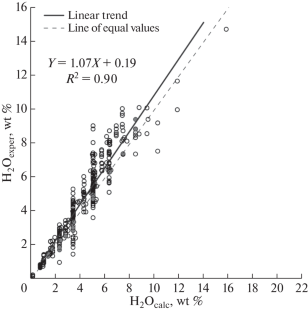An Equation for the Calculation of Saturated Water Contents in Silicate Melts: A New Version
IF 0.8
4区 地球科学
Q4 GEOCHEMISTRY & GEOPHYSICS
引用次数: 0
Abstract
A set of experimental data compiled from the literature comprises results of 394 quenching experiments that characterize the saturated water content within wide ranges of intensive parameters of silicate systems. Analysis of the main types of published models of water solubility in silicate melt showed that the equation by G. Moore et al. (1998) best describes experimental results. The Moore equation, converted to an exponential form, was recalibrated on an extended set of experimental data, and the new coefficients for this equation are: a = 918; bAl2O3 = – 0.712; bFeO = – 0.749; bNa2O = 0.806; c = 1.087; and d = –11.45. The Moore equation with new coefficients makes it possible to predict the saturated water content in silicate melts accurate to ±1 to ±2 relative % in the range of melt compositions from basalt to rhyolite, pressures from atmospheric to 15 kbar, and temperatures from 550 to 1300°C.

硅酸盐熔体饱和水含量计算公式的新版本
从文献中编译的一组实验数据包括394个淬火实验的结果,这些实验表征了硅酸盐系统在广泛的密集参数范围内的饱和水含量。对已发表的主要类型的硅酸盐熔体水溶性模型的分析表明,G. Moore等人(1998)的方程最能描述实验结果。将摩尔方程转换为指数形式,在扩展的实验数据集上重新校准,该方程的新系数为:a = 918;bAl2O3 = - 0.712;bFeO = - 0.749;bNa2O = 0.806;C = 1.087;d = -11.45。在玄武岩到流纹岩的熔融成分范围内,压力从大气压到15kbar,温度从550°C到1300°C,用新系数的摩尔方程可以准确地预测硅酸盐熔体中饱和水的含量,准确度为±1到±2相对%。
本文章由计算机程序翻译,如有差异,请以英文原文为准。
求助全文
约1分钟内获得全文
求助全文
来源期刊

Geochemistry International
地学-地球化学与地球物理
CiteScore
1.60
自引率
12.50%
发文量
89
审稿时长
1 months
期刊介绍:
Geochemistry International is a peer reviewed journal that publishes articles on cosmochemistry; geochemistry of magmatic, metamorphic, hydrothermal, and sedimentary processes; isotope geochemistry; organic geochemistry; applied geochemistry; and chemistry of the environment. Geochemistry International provides readers with a unique opportunity to refine their understanding of the geology of the vast territory of the Eurasian continent. The journal welcomes manuscripts from all countries in the English or Russian language.
 求助内容:
求助内容: 应助结果提醒方式:
应助结果提醒方式:


